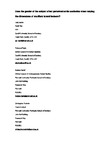Does the gender of the subject affect perceived smile aesthetics when varying the dimensions of maxillary lateral incisors?
| dc.contributor.author | Tan, D | |
| dc.contributor.author | Playle, R | |
| dc.contributor.author | Harris, AJ | |
| dc.contributor.author | Tredwin, Christopher | |
| dc.contributor.author | Addy, L | |
| dc.date.accessioned | 2018-08-14T08:07:05Z | |
| dc.date.available | 2018-08-14T08:07:05Z | |
| dc.date.issued | 2018-08-10 | |
| dc.identifier.issn | 0007-0610 | |
| dc.identifier.issn | 1476-5373 | |
| dc.identifier.uri | http://hdl.handle.net/10026.1/12134 | |
| dc.description.abstract |
OBJECTIVE: To assess whether subject gender influences aesthetic opinion when altering the width of maxillary lateral incisors. METHOD: Photographs of a male and a female smile, displaying only the lips and teeth, were digitally altered to produce images where the maxillary lateral incisor was proportioned 52%, 57%, 62%, 67%, 72% and 77% in relation to the width of the maxillary central incisor. The image was then made symmetrical. One hundred participants (50 male and 50 female) were asked to rank each set of photographs from 'most' to 'least attractive'. RESULT: The 57% lateral incisor was considered the 'most attractive' with the 77% lateral incisor the 'least attractive' however no statistically significant difference existed with relation to subject or rater gender. CONCLUSION: Neither the 'golden proportion' nor the 'Recurrent Aesthetic Dental' ('RED') proportion was deemed the most attractive. As subject gender did not have a significant effect, dentists should work to create aesthetic results on an individual basis, operating within a so-called 'golden range'. | |
| dc.format.extent | 235-240 | |
| dc.format.medium | Print-Electronic | |
| dc.language | en | |
| dc.language.iso | en | |
| dc.publisher | Springer Nature [academic journals on nature.com] | |
| dc.subject | Adult | |
| dc.subject | Aged | |
| dc.subject | Attitude | |
| dc.subject | Esthetics, Dental | |
| dc.subject | Female | |
| dc.subject | Humans | |
| dc.subject | Incisor | |
| dc.subject | Male | |
| dc.subject | Maxilla | |
| dc.subject | Middle Aged | |
| dc.subject | Photography | |
| dc.subject | Sex Factors | |
| dc.subject | Smiling | |
| dc.subject | Young Adult | |
| dc.title | Does the gender of the subject affect perceived smile aesthetics when varying the dimensions of maxillary lateral incisors? | |
| dc.type | journal-article | |
| dc.type | Journal Article | |
| plymouth.author-url | https://www.webofscience.com/api/gateway?GWVersion=2&SrcApp=PARTNER_APP&SrcAuth=LinksAMR&KeyUT=WOS:000441289800028&DestLinkType=FullRecord&DestApp=ALL_WOS&UsrCustomerID=11bb513d99f797142bcfeffcc58ea008 | |
| plymouth.issue | 3 | |
| plymouth.volume | 225 | |
| plymouth.publication-status | Published | |
| plymouth.journal | British Dental Journal | |
| dc.identifier.doi | 10.1038/sj.bdj.2018.543 | |
| plymouth.organisational-group | /Plymouth | |
| plymouth.organisational-group | /Plymouth/Faculty of Health | |
| plymouth.organisational-group | /Plymouth/Faculty of Health/Peninsula Dental School | |
| plymouth.organisational-group | /Plymouth/REF 2021 Researchers by UoA | |
| plymouth.organisational-group | /Plymouth/REF 2021 Researchers by UoA/UoA03 Allied Health Professions, Dentistry, Nursing and Pharmacy | |
| plymouth.organisational-group | /Plymouth/Users by role | |
| plymouth.organisational-group | /Plymouth/Users by role/Academics | |
| dc.publisher.place | England | |
| dcterms.dateAccepted | 2018-03-20 | |
| dc.rights.embargodate | 2018-9-20 | |
| dc.identifier.eissn | 1476-5373 | |
| dc.rights.embargoperiod | Not known | |
| rioxxterms.versionofrecord | 10.1038/sj.bdj.2018.543 | |
| rioxxterms.licenseref.uri | http://www.rioxx.net/licenses/all-rights-reserved | |
| rioxxterms.licenseref.startdate | 2018-08-10 | |
| rioxxterms.type | Journal Article/Review |


